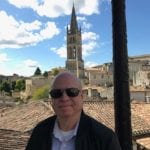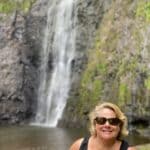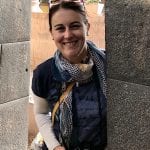Ecuador: No Place Like It and Good For Travelers
My recent trip was full of surprises, and the first was the World Heritage site and 9,000-foot elevated capital of Quito.
Authorities have gone to great lengths to preserve the colonial core of the city. Not a Prada or Escada store to be found.
Instead, you find authentic, Colonial architecture; churches such as The San Francisco Cathedral covered in every inch inside with gold leaf and carvings; artisans grinding corn, making hats or processing their unique chocolate into culinary works of art. This is not touristy; these are shops open for the local residents.
Our home in Old Town Quito was the impressive and historic Hotel Casa Gangotena, a small boutique hotel overlooking Plaza San Francisco.
Major outside construction of a new metro is winding down there and we had no issues with noise or dust. The Old Town is definitely where you want to be situated. Service could not have been better with prompt, efficient and thoughtful attention to detail.
For example, upon our late arrival a couple of small sandwiches were delivered without asking. Each evening it was a trio of homemade cookies/chocolates at turn down as opposed to the more common single piece of pre-wrapped candy. The beds were like sleeping on a cloud.
Across the street was a huge find of the private Casa del Alabado Archaeological Museum. Some of the fantastic pieces date back some 5,000 years. They are in amazing shape, displayed in a restored 17th-century colonial mansion. Some of the pieces are real eye openers of originality and creativity for a period long ago.
Of course, the newer part of Quito is worth exploring, too. It is about a 20-minute drive and about 10USD in a taxi, but well worth it. Here numerous galleries mixed in with basic services are the rewards.
Do your shopping research before you arrive as there is no one street or area here. Food was outstanding whether it was at our hotel or the tasty Zazu, a Relais & Chateau experience in the heart of Quito’s New Town.
After a few days in Quito, we moved on to what the BBC has designated as one of the Top Ten Unique Lodges of the World, The National Geographic Mashpi Lodge Reserve.
Not the easiest place to get to, Mashpi is well worth the 3 1/2 hour drive from Quito, crossing The Equator, with the last 1 1/2 hours on a gravel and dirt road. I recommend a private transfer as opposed to a bus transfer.
We passed through large gates into the 3,200-acre reserve, then on the last turn saw the glorious glass and steel of our 30-room home for the next three days.
From every angle inside, you had views of tropical green jungle. The rooms were very comfortable, but with no TV’s. The food was amazing and gourmet.
The star of the show everyday was the preserved world outside, with hikes along some challenging trails, exploring nature. Very experienced guides took us on treks with provided rubber boots and rain parkas (if required).
There were unique vantages, such as the 655-foot Sky Bike, where you pedal above the forest, or the two-mile long Dragon Fly (extra cost of 50 USD per person). Other than Dragon Fly and alcohol, the experience was all inclusive.
This eye-opening world, saved from destruction by a former mayor of Quito, opens up to you with the help of expert guides.
Eagles, hummingbirds, a butterfly station, learning how a forest regenerates, and what it means to the environment as well as to other animal residents, are here to experience.
The trails can be very challenging and slippery. It takes effort, but it is exercise with purpose, education and enrichment.
After a brief overnight back in Quito, it was on to another exciting experience in the famous Galapagos Islands. No other place on earth duplicates them.
This added a travel experience of a lifetime to an already memorable adventure. No amount of research could prepare us for what was to come.
The focus now is controlled tourism and to reintroduce and expand species such as the giant tortoise, which were previously hunted. Our home for the five days was the modern Santa Cruz II. With about 90 passengers, it is one of the biggest ships cruising these islands.
There are some boats as small as 8 cabins, but I prefer a bigger vessel for more choices of activities, on and off the ship. Every entry from beginning to end was via zodiac boats, including getting the luggage on and off the ship.
We began with our 3 1/2 flight from Quito arriving on San Cristobal Island and ending 5 days later on Baltra.
In between, we explored Punta Pitt (San Cristobal Island), Santa Fe Island, South Plaza Island, Puerto Ayora, Santa Cruz Island and Espanola Island.
Each was different with unique combinations of landscapes and wildlife: lush or barren, full of birds, sea iguanas, sea lions or all of the above.
The giant tortoises were impressive; some about 150 years old. My itinerary was one of several available. Excursions were more than just hikes, with opportunities to kayak, snorkel, scuba dive, mountain bike, swim and more.
What was unique, however, was the interaction with the wildlife. Rules are to be at least 6 feet from a native animal. I guess the animals did not get the emails. A sea lion pup was chasing a 4 year old girl, playing for sure. Hundreds of sea iguanas blocked our path.
Mockingbirds pecked at my shoes in curiosity. Fregatdae birds tried to help themselves at a local fish market.
The Charles Darwin Research Station continues to study animal behavior.
The animals have no fear and that is the seduction of The Galapagos.
It must be noted that there are challenges. The ship is comfortable but not luxury, there are no TV’s and very limited connectivity.
Boarding and disembarkation as always can be a bit of a challenge via zodiacs, and you must attend the daily briefings to give you the knowledge to decide which excursions are right physically and mentally for you.



